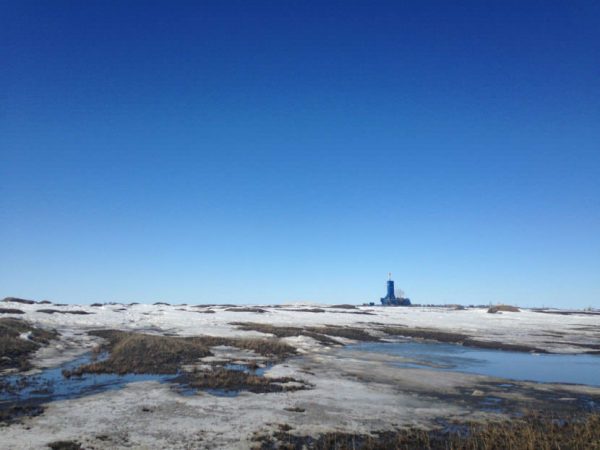The $5.6 billion BP-Hilcorp deal has huge implications for Alaska’s petroleum industry. But if you don’t work for an oil company, you might be wondering: Why should I care? And why does this matter?
The acquisition raises an array of questions about what will happen when BP, which has deep roots in Alaska, finalizes the sale of its assets to Hilcorp, a privately-owned company that’s operated in the state for less than a decade.
Hilcorp’s leaders will make many of those decisions, but the company is notoriously press-averse and did not make its executives available for interviews Tuesday. In an email, spokesman Justin Furnace said it would take time before the company releases details about its plans for workers, like how many could be laid off.
“BP’s workforce on the North Slope is obviously vital to the operation. Our plans for that workforce will develop as we determine how we will integrate the acquisition into Hilcorp’s existing operations and we receive a list of eligible employees from BP so we can begin the interview process,” Furnace said. As for Hilcorp’s vision for its new stake in the Prudhoe Bay field, which produces $17 million of oil each day, Furnace said: “We will be working to evaluate new opportunities at Prudhoe, but this process will take many months.”

Without many details from Hilcorp, we turned to experts to help answer four of the biggest questions raised by the acquisition:
1. Should Alaskans be worried about Hilcorp investing less money in workers and infrastructure, since the company has a reputation for cost-cutting?
Not necessarily, said Bill Popp, president of the Anchorage Economic Development Corporation. (Popp is also on the board of directors of Alaska Public Media.)
Popp said he thinks there may be initial job losses as a result of the deal. But many of those positions could be replaced with contractors, he added.
And, Popp said, it’s possible Hilcorp will make new investments in Prudhoe Bay to try to boost oil production, while BP might not have. Hilcorp is known for reviving oil fields that were previously in decline.
“On the face of it, not knowing what Hilcorp’s detailed plans are yet, I still believe that in all likelihood we are going to see a net increase in economic activity in the coming years, after the transition is completed,” Popp said.
2. What does the Hilcorp deal say about Alaska’s oil-fueled economy more broadly?
Alaska’s economy has run on oil since the trans-Alaska pipeline switched on in 1977. But production has been steadily declining since the 1980s, and some analysts said they saw BP’s departure as another sign of the decline of fossil fuels’ importance in the state.
But that’s not the only way to interpret Tuesday’s news, said Mouhcine Guettabi, an economist at University of Alaska Anchorage’s Institute of Social and Economic Research. BP is leaving the state, he said, but there’s also an interested buyer at the other end of the sale.
“To me, that was the thing: Rather than view it as, ‘BP no longer sees Alaska as attractive,’ maybe BP found somebody that’s willing to pay a handsome price for these fields,” Guettabi said. “I don’t know that this is the definitive statement to the decline in the importance of oil in Alaska’s economy.”
3. BP is known for its philanthropic presence in Alaska. Will Hilcorp continue that tradition?
BP said it gave away more than $4 million last year to Alaska organizations, and it has its own community meeting center that nonprofits can use for free.
Tuesday’s news is likely to cause anxiety in Alaska’s nonprofit world, especially given how much turmoil recent state budget cuts have caused for organizations, said Diane Kaplan, president of the Rasmuson Foundation, Alaska’s largest private grantmaker.
“I think it’ll be unsettling to the nonprofit community to have that change on top of all the other changes going on,” she said.

Kaplan pointed out that Hilcorp has a program where it sets aside $2,500 in a charitable giving account for each new employee, then matches donations of up to $2,000 a year. And she said she’s hopeful that the company is serious about establishing a strong philanthropic presence in Alaska.
One reason for that, Kaplan said, was a meeting that a group of senior Hilcorp executives requested with her a few weeks ago, before the sale took place. They wanted to discuss charitable giving, she said, though they wouldn’t address the then-swirling rumors of the possible purchase of BP’s assets.
“It was a very good meeting. We were really happy, especially now that we know what the outcome of the discussions with BP were, that they took the time at a busy time to come and talk about philanthropy,” Kaplan said. “I’d say that’s a very good sign.”
Furnace, the Hilcorp spokesman, said in an email that “giving back to the communities where we live and work is very important to Hilcorp and to our employees.” He pointed to more than $2 million in past contributions by the company and its employees to Alaska-based charities – they totaled nearly $315,000 last year – as well as money set aside for scholarships.
4. What about Hilcorp’s environmental and safety record?
The company has had multiple accidents since it started operating in Alaska in 2012. State regulators levied fines against Hilcorp in 2017 after three North Slope workers nearly died from inhaling nitrogen during a well cleanup.
The same year, one of its pipelines in Cook Inlet, not far from Anchorage, leaked natural gas for weeks, prompting Hilcorp to temporarily shut down an associated oil platform after discussions with then-Gov. Bill Walker.
And in December, a worker for a Hilcorp contractor was killed in a drilling accident on the North Slope.
In an email, Furnace said “if we can’t do a project safely and responsibly, we will not undertake that project.”
“While we have not been incident-free, Hilcorp has focused intently on achieving high standards of safety and environmentally responsible operations throughout our Alaskan operations,” he said. “We do this through close coordination with local, state, and federal agencies that work to enhance public safety, improve emergency preparedness and protect the environment. And just as importantly, we do this through the continual building of a company culture that upholds and rewards integrity, accountability and responsibility.”
But environmental advocates quickly raised questions about the deal.
“Hilcorp’s business model is to come in to old fields and to bring out the profits. And to do that, it has to cut corners with worker safety and environmental protection,” said Bob Shavelson, advocacy director at Cook Inletkeeper and a strident Hilcorp critic. “And we’ve seen that time and time again in Cook Inlet.”




